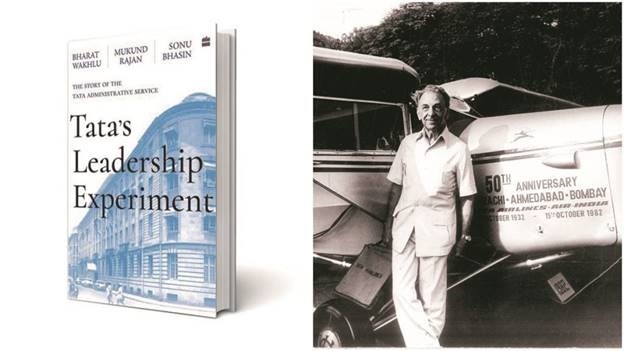The story of Tata Administrative Service provides valuable insights into the changing business environment in India
The book explores the journey of TAS over the past six decades, and examines where it succeeded, faltered or even failed, while explaining the reasons thereof.
By Amitabha Bhattacharya
The Tata Administrative Service (TAS), as the name suggests, was broadly modelled on the pattern of the IAS, as a leadership service. JRD Tata was deeply influenced by a former ICS officer, John Peterson, and having spent his early years in France, JRD knew that in French society cadres represented something special, and ‘their collective identity had jumped the divide from being purely professional, to commanding social positions and status.’ JRD, as the authors note, was mindful that the IAS was the most aspirational civil service in India, and recognised the value of the steel frame’s equivalent for the Tata Group.
Freddie A Mehta (TAS 1956), a doctorate from the London School of Economics in his twenties, was the first recruit. The process of recruitment from a few renowned institutions was rigorous and multi-staged, aimed at selecting bright young men and women for leadership positions in Tata enterprises. Jamsetji’s vision to create an enterprise ‘based on the trust of all the stake holders’ and JRD’s belief that ‘We are in the business of nation building’ developed a sense of values that the members of the TAS were expected to imbibe, carry forward and deepen. Has that vision been actualised? The book explores the journey of TAS over the past six decades, and examines where it succeeded, faltered or even failed, while explaining the reasons thereof.
Written by three former TAS officers, the book is based on detailed research and interviews with former and serving members of the service and shows the strengths and weaknesses of this ambitious experiment. Was it too ambitious to be modelled on the IAS? What were the fault lines? Why does it appear to have lost steam in today’s aspirational India? Even in its heydays, why was the attrition in the TAS significant? However, the authors underline that many of those who had left the TAS for various reasons made their mark in their chosen areas. Raghuram Rajan, Navtej Sarna and Arun Maira, for example.
JRD was driven by idealism, but there were inherent problems in the way the scheme was introduced and sought to be implemented. With the arrival of “this new animal on the horizon called the ‘MBA’”, the TAS batch of 1970, for example, had all MBAs or engineers with MBAs. Consequently, some of the Oxbridge graduates felt like misfits and, therefore, quit. Is monoculture compatible with diversity that JRD had in mind? It is noteworthy that the Tata Consultancy Services also did not give much traction to this service.
The book chronicles the distinct phases the Tata enterprises had to pass through, especially in the post-JRD era from 1991 when bold economic reforms started pushing India towards free enterprises, exposing the enterprises to greater competition and unshackling them from the infamous licence-permit Raj. The role of TAS has to be viewed in the context of this paradigm shift that affected the way the Tata companies had hitherto been functioning.
Did the TAS as a cadre facilitate such welcome changes? The answer is complex. Meanwhile, as the authors note, major shifts were occurring within the Tata set-up. Professional managers like Russi Mody, Sumant Moolgaokar and others were running flagship companies like TISCO and TELCO with elan, displaying no great respect for TAS as a system. They became powerful forces—‘satraps’ as the book describes them—so much so that in 1991, at an Officers’ Dialogue organised in Jamshedpur, JRD said, “You, Russi, are the Maharaja of Jamshedpur and I couldn’t have come here unless you deigned to invite me.” In the same month, Ratan Tata succeeded JRD as the chairman of Tata Sons, leaving behind senior, potential contenders “like Russi Mody, Darbari Seth and Nani Palkiwala”.
With Ratan Tata leading the Tatas towards a new world, a period started which the TAS cadre had to adjust itself to. Individual officers were valued, but some who had identified themselves with the ‘satraps’ had to exit. In a chapter titled Getting Rid of the Satraps, the authors point out that many senior Tata leaders stepped down from the board of Tata Sons from 1999 in quick succession, yielding a generational change in the board’s composition. This had major implications for the TAS. The book narrates how Ratan Tata asserted his authority preparing Tata companies to face international competition with a new thrust on quality—championing technology, sustaining Tata values, restructuring portfolios and going global. The successes of home-grown businesses like TCS and Titan have been highlighted, and some of the steps that misfired have also been alluded to.
To what extent has JRD Tata’s experiment to find officers to provide leadership talent for Tata companies succeeded? To put it very politely, it was a mixed success. Admittedly, there have been outstanding specimens of the TAS, but “managers from outside the TAS such as Jamshed J Irani at Tata Steel, S Ramadorai at TCS, Ravi Kant at Tata Motors, would enjoy significantly more influence in shaping the fortunes of these companies”. The reasons for TAS not reaching its potential have been many—inadequate career planning, weakening TAS secretariat, lack of focus on training and development, high attrition (especially among lady officers), traditionally being “behind the curve on offering market standard compensation” and the like.
The story of the TAS in the context of how Tata enterprises have been overcoming challenges and difficulties, and still retaining their distinctive edge, provides valuable insights into the changing business environment in India. There are many lessons to be learnt from this absorbing discourse, lucidly articulated.
Amitabha Bhattacharya is a former IAS officer who has also worked in the private sector and with the UNDP
Tata’s Leadership Experiment: The Story of the Tata Administrative Service
Mukund Rajan, Sonu Bhasin, Bharat Wakhlu
HarperCollins
Pp 300, Rs 699

